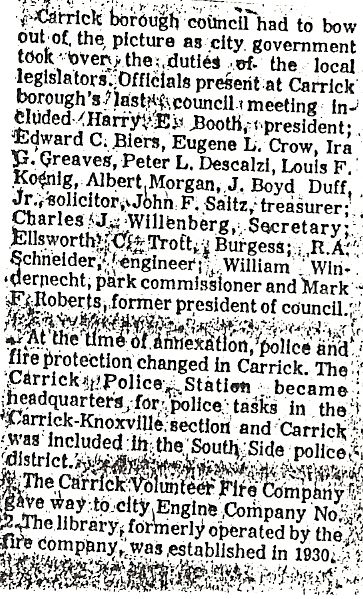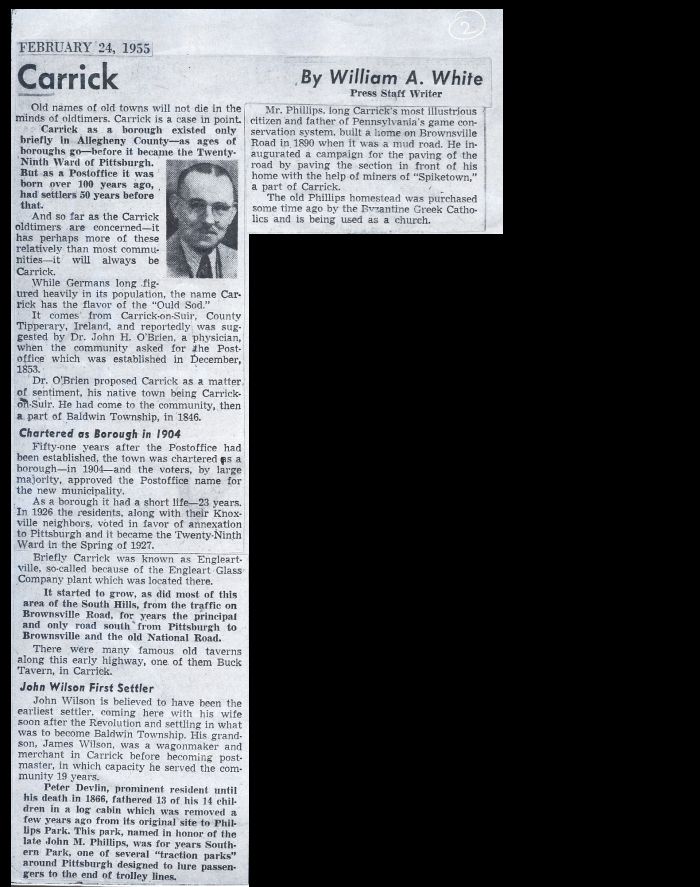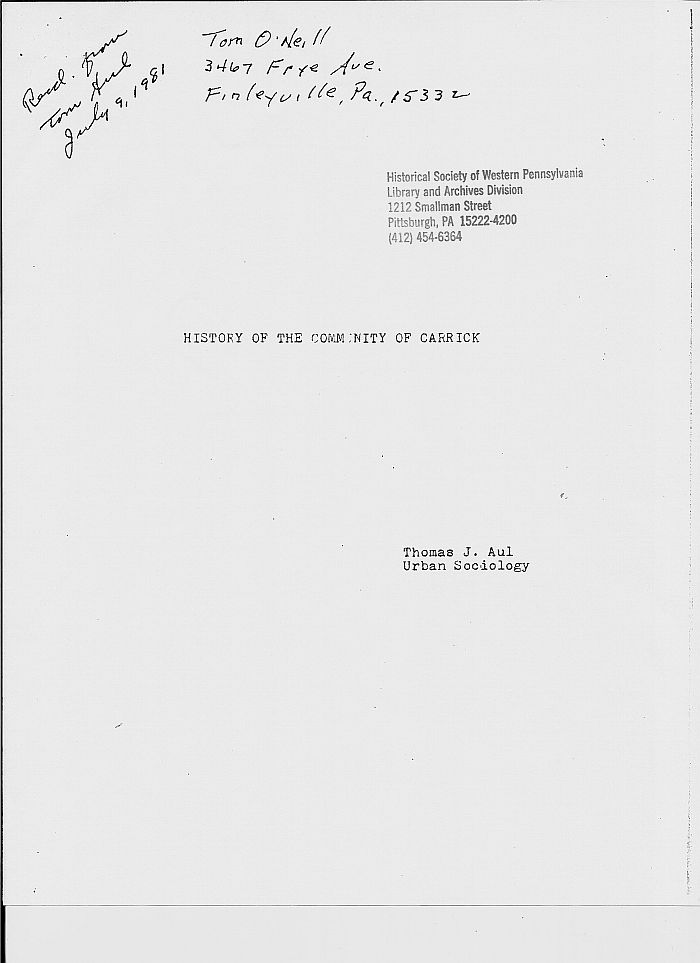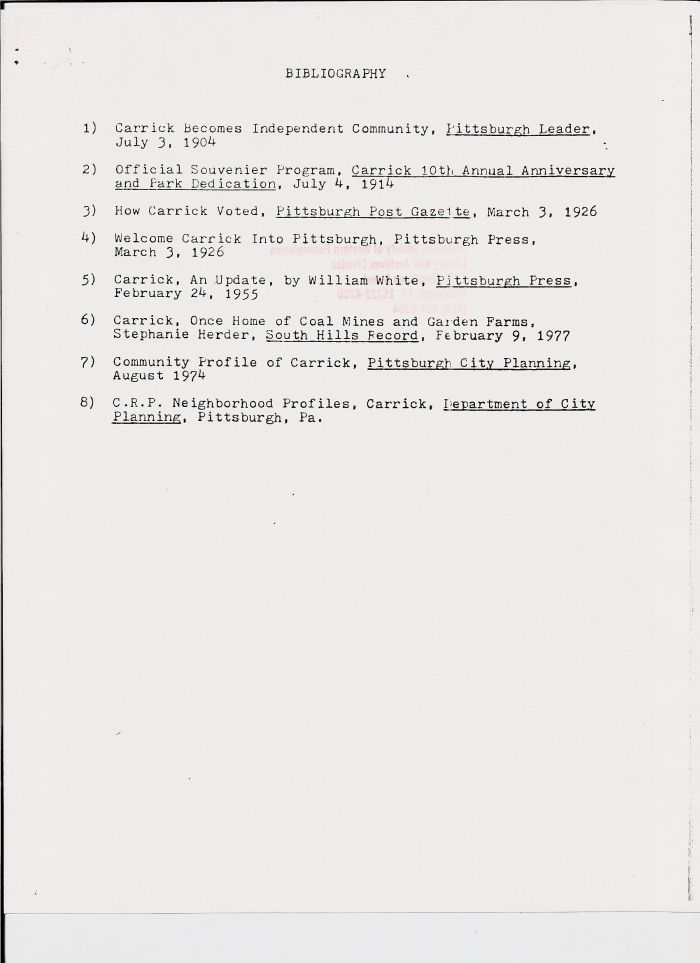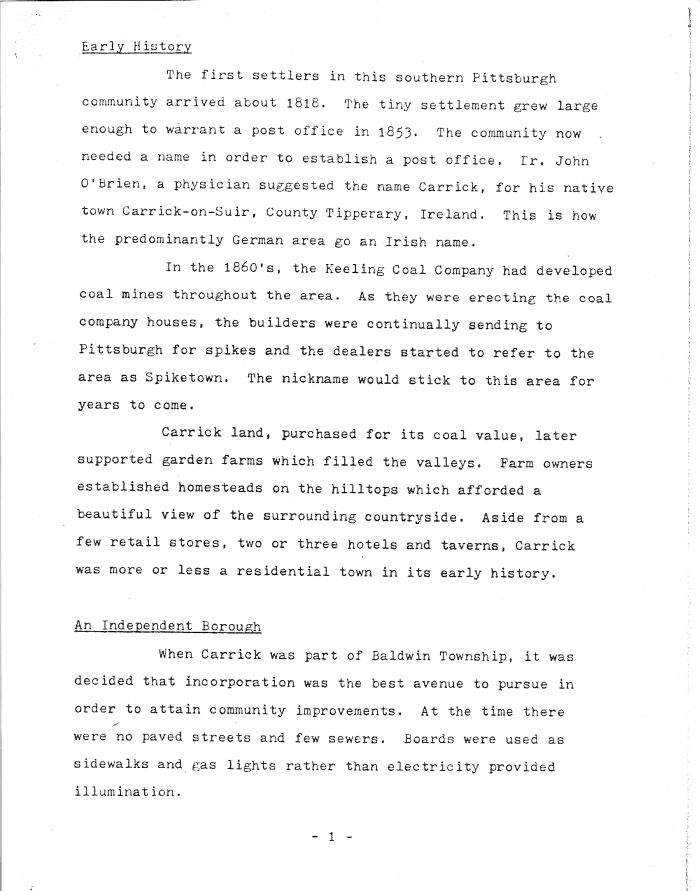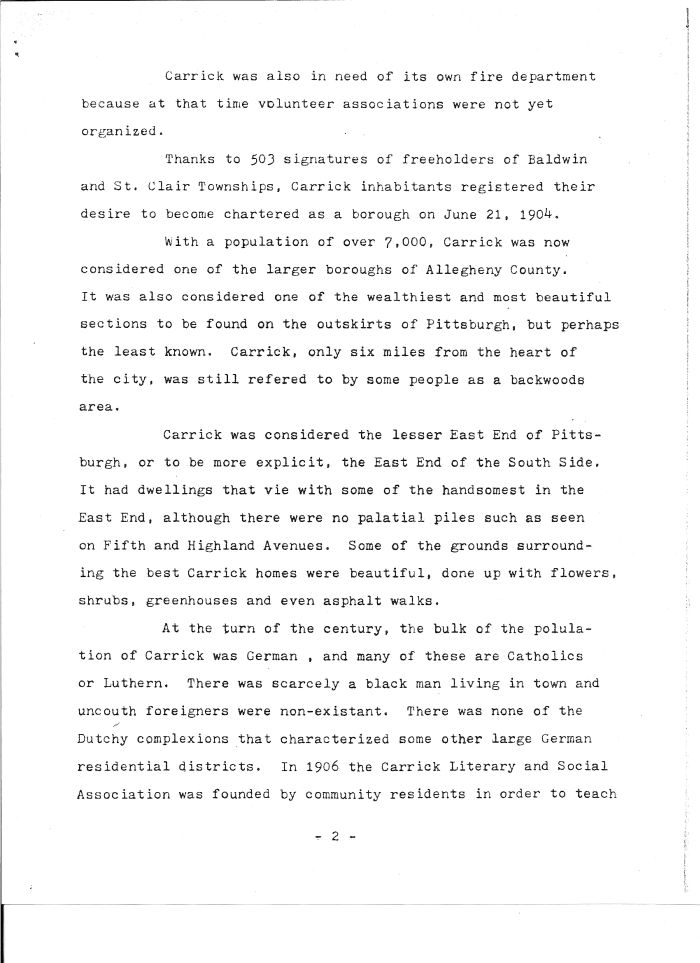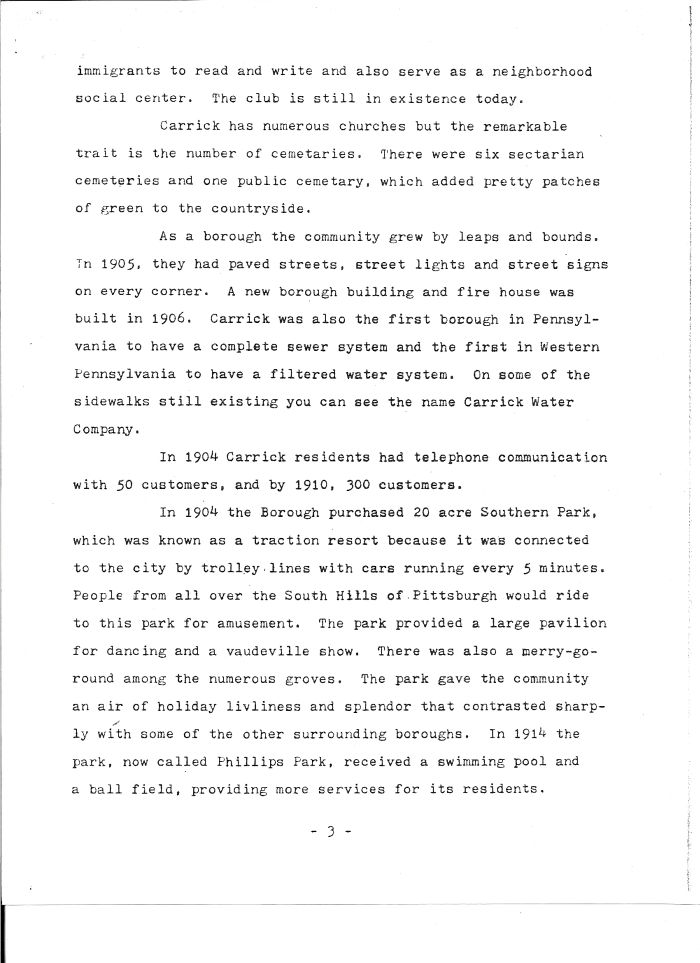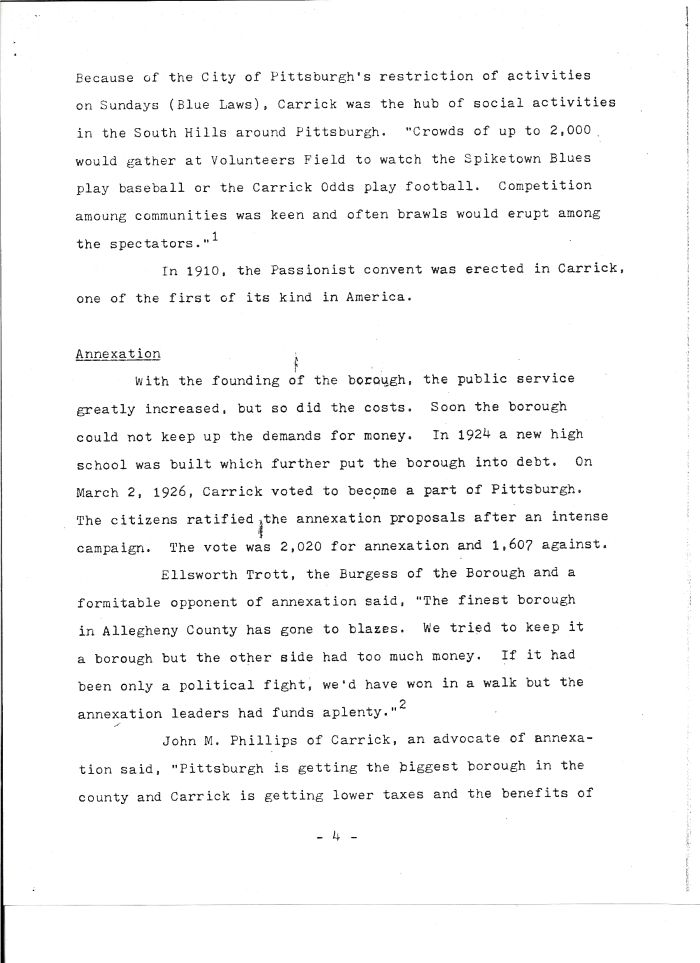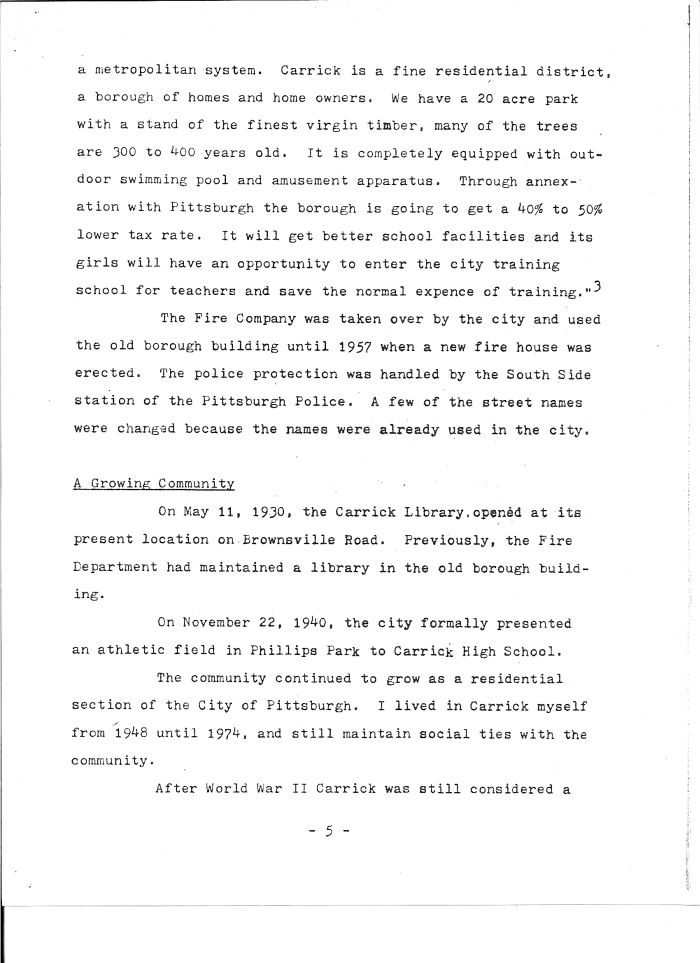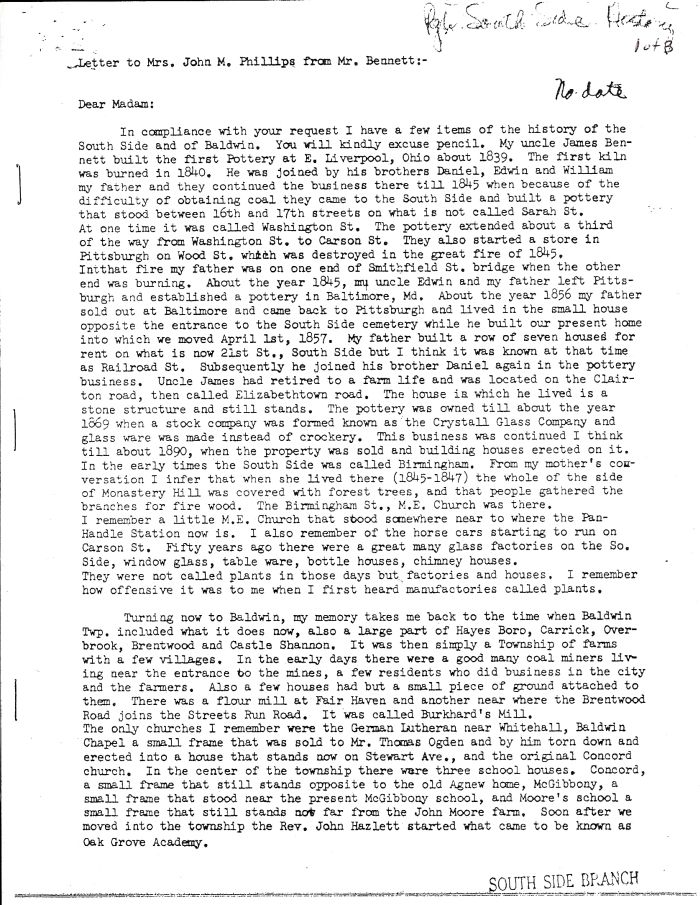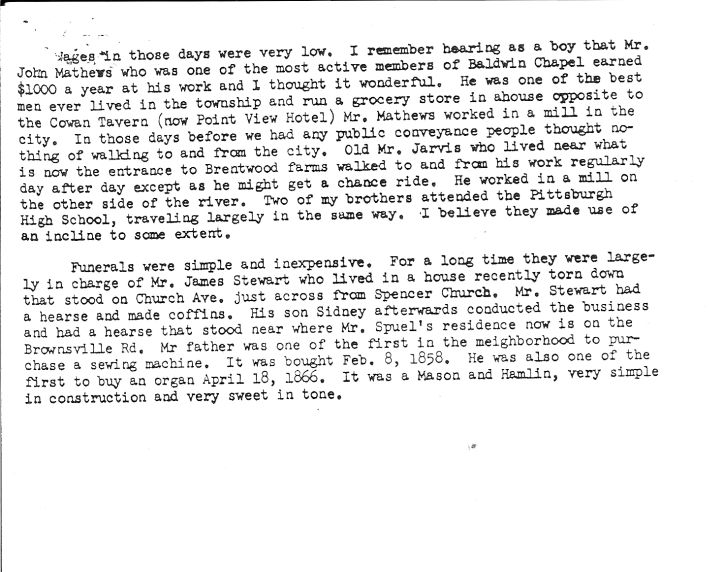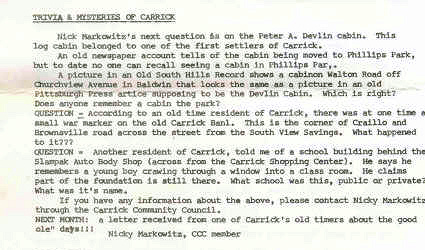Difference between revisions of "Articles about Carrick"
| (4 intermediate revisions by the same user not shown) | |||
| Line 66: | Line 66: | ||
Next to the South Side cemetery is St. Adelbert’s Roman Catholic (Polish) cemetery, established in 1894 by Rev. L. M. A Miskiewicz, the able pastor of the big church on South Fifteenth street, South Side. It is a beautiful place, St. George’s cemetery, also a Roman Catholic burial ground, adjoins that of St. Joseph. | Next to the South Side cemetery is St. Adelbert’s Roman Catholic (Polish) cemetery, established in 1894 by Rev. L. M. A Miskiewicz, the able pastor of the big church on South Fifteenth street, South Side. It is a beautiful place, St. George’s cemetery, also a Roman Catholic burial ground, adjoins that of St. Joseph. | ||
| + | |||
| + | == Article of Carrick Borough's last meeting before becoming part of the city of Pittsburgh == | ||
| + | |||
| + | [[Image:Carrick borough historical record.jpg]] | ||
== Newspaper article written by William A. White in 1955 == | == Newspaper article written by William A. White in 1955 == | ||
| Line 84: | Line 88: | ||
[[Image:Tom aul history of carrick page 7.jpg]] | [[Image:Tom aul history of carrick page 7.jpg]] | ||
[[Image:Tom aul history of carrick page footnotes.jpg]] | [[Image:Tom aul history of carrick page footnotes.jpg]] | ||
| + | |||
| + | |||
| + | == Letter to Mrs. Harriet Duff Phillips by Mr. Bennett - no date == | ||
| + | |||
| + | [[Image:Early carrick history letter 1.jpg]] | ||
| + | |||
| + | [[Image:Early carrick history letter 2.jpg]] | ||
| + | |||
| + | [[Image:Early carrick history letter 3.jpg]] | ||
| + | |||
| + | |||
| + | |||
| + | == The end of Carrick as a borough: == | ||
| + | |||
| + | [[Image:Carrick borough historical record.jpg]] | ||
| + | |||
| + | |||
| + | == Carrick Trivia by Nick Markowitz == | ||
| + | |||
| + | [[Image:Carrick Trivia.jpg]] | ||
| + | |||
| + | |||
| + | == [http://www.post-gazette.com/pg/09323/1014574-55.stm Honoring lost legacy of familiar namesake in Carrick] == | ||
| + | |||
| + | |||
| + | == Thursday, November 19, 2009 == | ||
| + | |||
| + | |||
| + | == By Ken McCarthy == | ||
| + | |||
| + | [[Carol Anthony]] grew up in Carrick and remembers walking past the mansion overlooking [[Brownsville Road]] and wondering who lived in the big house and what their lives must be like. | ||
| + | |||
| + | "It took 50-some years, but I finally had my questions answered," said Ms. Anthony, a founding member of the Carrick-Overbrook Historical Society. | ||
| + | |||
| + | The historical group did research, raised money and has now erected a historical marker honoring [[John M. Phillips]], the former owner of the mansion, which was called [[Impton]] and is now the site of [[St. Pius X Catholic Church]]. | ||
| + | |||
| + | "When we got involved in this and started putting it together, it was interesting to note how many people became educated through the process," said John Rudiak, a member of the historical society. "People would go to [[Phillips Park]], but they didn't know why it was called that. Even the Game Commission largely forgot about his contributions." | ||
| + | |||
| + | Mr. Phillips was the creator of the State Game Lands, which were used as models for the rest of the country, Mr. Rudiak said. He also was one of the founders of Pymatuming State Park. | ||
| + | |||
| + | In addition, he helped start the first Boy Scout troop in the state, although he was never a Scout himself, Mr. Rudiak said. | ||
| + | |||
| + | Phillips Elementary School also is named after Mr. Phillips. | ||
| + | |||
| + | Born in 1863, Mr. Phillips was a conservationist, industrialist and engineer. He was president of Phillips Mining and Manufacturing Co. on the South Side. | ||
| + | |||
| + | The historical society received approval in July for the marker from the Pennsylvania Historical and Museum Commission but needed to raise about $1,350 to pay for about half the cost of the bronze piece. | ||
| + | |||
| + | Mr. Rudiak said that was achieved through individual donations, including about half from Mr. Phillips' descendents. Some of the Phillips family attended the Oct. 31 ceremony to unveil the marker. | ||
| + | |||
| + | "It was the first time many of them had stepped foot on the property for years," Mr. Rudiak said. "But they remembered being there as children." | ||
| + | |||
| + | "As we dug into the history, we became more and more impressed by what this one family was able to achieve," Ms. Anthony said. "We wanted to share what we were finding." | ||
| + | |||
| + | Julia Tomasic, another founding member of the historical society, said seeing old photos of the Phillips' mansion piqued her interest to find out more about the family. | ||
| + | |||
| + | "I mean this house and all the questions you might consider when seeing something that isn't there anymore kept me obsessed," she said. "I see Carrick as a typical city neighborhood with its typical issues, but I also see a gem in our rich history. It was forgotten, but I want it to live on and let the next 100 years of Carrick residents remember when things get rough here that this place is worth fighting for. It's worth saving." | ||
| + | |||
| + | [[Natalia A Rudiak]], a member of the historical society and city councilwoman-elect for District 4, believes the marker can offer hope to Pittsburgh's Carrick neighborhood. | ||
| + | |||
| + | "Many residents do not realize what wonderful history they have in their own backyards, and we hope folks are inspired by the past to feel confident in the future," she said. "This is not just a historical marker, but it was a foundation for our community." | ||
| + | |||
| + | Freelance writer Ken McCarthy can be reached in care of suburbanliving@post-gazette.com. | ||
| + | |||
| + | Read more: [http://www.post-gazette.com/pg/09323/1014574-55.stm#ixzz0YleuvmHR click here] | ||
| + | |||
| + | [[Image:Phillips Marker 1.JPG]] | ||
| + | Photo by [[Natalia A Rudiak]] | ||
Latest revision as of 16:10, 4 December 2009
Contents
- 1 PITTSBURG LEADER JULY 3, 1904
- 2 Article of Carrick Borough's last meeting before becoming part of the city of Pittsburgh
- 3 Newspaper article written by William A. White in 1955
- 4 Research Paper written by Tom Aul
- 5 Letter to Mrs. Harriet Duff Phillips by Mr. Bennett - no date
- 6 The end of Carrick as a borough:
- 7 Carrick Trivia by Nick Markowitz
- 8 Honoring lost legacy of familiar namesake in Carrick
- 9 Thursday, November 19, 2009
- 10 By Ken McCarthy
PITTSBURG LEADER JULY 3, 1904
(This is rewrite of the original story that appeared in The Pittsburg Leader, July 3, 1904)
The town of Carrick on the historic Brownsville road, incorporated into a borough, June 21st last, is the latest arrival in the big family of fifty boroughs to be found in Allegheny county. Although one of the largest, wealthiest and most beautiful sections to be found on the outskirts of the city it is perhaps the least known. That such is the case illustrates that not only does one-half the world not know how the other half lives, but it is equally as ignorant as to where it lives. The chances are that if nine out of ten Pittsburgers were asked where Carrick is they could not answer. If asked to describe the place they would be equally at sea. Those who have heard of Carrick almost invariably think of it as the person mentioned in this paragraph, who on being informed by his friend that had moved to the town, asked: “To Carrick; where on earth is that?”
“Five miles out the Brownsville road,” replied the one who had just taken up his domicile there.
“Is it in the city?”
“No, indeed; it is in Baldwin township.”
“Baldwin township! That’s the limit. What in the world did you move away out there for? You must have wanted to get into the backwoods.”
It may be remarked right here that in the minds of most people who do not live on the South Side the mention of the name of Baldwin township brings up visions of Sunday beer drinking carnivals, baseball games law-breaking orgies of all kinds and mud roads, cows, roosters, dilapidated barns, country yawps, etc., adinfinitum. Many Pittsburgers, it seems never hear of Baldwin or read about it, either, unless it is in connection with a keg party, pounced upon by a constable or the county detective, or a baseball game that ends in a riot. Of late, however, such things have been rare in the township.
After the little dialogue herewith given the man who had moved out to Carrick explained to his friend that the town was not a country village or backwoods settlement, as many good people imagine, but it is a live, up to date residence town, with handsome, well-kept lawns and ideal home sites.
It may surprise thousands of Pittsburgers to learn that Carrick has a population of over 7,000; that it extends nearly three miles one way and a mile and a half the other; and that from the hilltops there are magnificent scenic panoramas, miles in extent, are to be seen. In fact, no finer views can be seen in any other borough.
Carrick is the lesser East End, or, to be more explicit, the East End of the South Side. There the wealth, culture and social cream of that great section is gathered. There are dwellings that vie with some of the handsomest in the East End, although there are no palatial piles, such as are seem pm Fifth and Highland avenues. Some of the grounds surrounding the best Carrick homes are beautiful are artistic in flowers, shrubbery, greenhouses and asphalt walks. In the first place, it is proper to explain just where the new borough lies. It is bounded thus: on the north by Mt. Oliver borough and populous Lower St. Clair township; on the west by Baldwin township, the little village of Fairhaven almost rubbing noses with the big borough; on the northwest by Reflectorville, and another village in Baldwin township; on the south by the township, and on the east by the lower part of the same. Becks run forms the eastern boundary and Sawmill run on the western, while the Mt. Oliver borough line on the north is the old line between Noble and Griffin farms, the owners of these places having been pioneers in developing the great breezeswept tracts on the South Side hill.
Carrick consists of hill and dale, the modern dwellings being mostly built on the hills. If the valleys are to be seen some of the finest garden farms in the state, farms cultivated after scientific methods which yield a golden harvest enriching their owners. To the west away down in the valley, runs the narrow gauge Castle Shannon railroad, the funny little engine and cars rattling over a trestle as they steam out of Fairhaven and pass on to picturesque Castle Shannon.
The way to get to Carrick is to board a Knoxville and Mt. Oliver car on Wood Street. The journey is out Forbes street, over the Twenty-Second street bridge, around by Eighteenth street up the steep grade of that thoroughfare, formerly the Brownsville road over which coaches rolled in ante-bellum days, when passengers bound east and west came through Brownsville, where boats were taken on the long trip down the Monongahela and Ohio to the vast growing west. After reaching the top of the hill on the South side, at Arlington avenue, the journey is almost on the level and in a south-easterly direction. Few trolley rides in the county offer more varied or picturesque views of the Monongahela river with its lining of busy industrial establishments are to be had either way. Then as the car ascends the winding road to Mt. Oliver a superb panorama of the South Side, the river and the lower part of the city is to be seen. The invigorating breezes drive dull care away and make on forget the heat and the sweltering of the mortals in the hives of industry on the plains. After a brief stop to transfer passengers to the Arlington avenue line, out which the big cars bound for Charleroi, Finleyville and Castle Shannon roll, the swiftly moving Carrick car proceeds past Knoxville, Mt. Oliver and out Southern avenue, lined with handsome, comfortable homes set in gardens of beautiful green. To the right in a broad depression lies Knoxville and the populous town across the bridge on the old Swift farm, where rows of neat brick houses can be seen. One is impressed by the fact that a tremendous tide of progress is moving southward. The sea of humanity is rapidly invading the cool, soot-free highlands of the South Side. A mighty city in itself is being built on these broad acres. Where five years ago cornfields and market gardens were to be seen now there are thousands of neat, substantial homes and faultlessly paved streets. Almost every city convenience is to be found there. One asks himself what the magnitude of the vast, desirable section will be like when the rapid transit tunnel line under Mt. Washington is completed in September and home seekers will be placed within ten minutes safe passage of the heart of the city.
Through Picturesque Lands
This great populous Swift farm colony almost adjoins Carrick. The car speeds on through Mt. Oliver and last arrives at the gate of St. Joseph’s Roman Catholic cemetery.
The northern line of the new borough passes a few rods north of this point. Opposite the cemetery at a graceful curve in the road is the picturesque home of the W. C. Bernardi, of the South Side. A fine ornamental wall has been recently built in front of the place, and a faultless lawn made. With the pretty green cemetery, full of white marble shafts, blooming rose bushes and shrubbery on one side and the handsome Bernardi home on the other, a most pleasing entrance to the borough is made. This makes a decidedly favorable impression on the visitor.
As the car proceeds, the ancient Buck tavern, with its hospitable low roof and sign with a buck on it, appears on the right. There is a pump here which is an irresistible attraction to the motormen and conductors, who never fail to hop off and quaff a cup of delicious, cold water.
Across the road is a beautiful little house set amidst equally beautiful trees. Such places are numerous in Carrick, as one sees before the ride ends. Half a mile from the ST. Joseph Cemetery the big South Side cemetery looms up on the right. Here are 43 ½ acres of exquisitely cultivated ground, lying in beauty with Allegheny or Homewood cemeteries, although the monuments are not of such costliness or high order of beauty as the ones to be seen in those great cities of the dead. A ling line of poplars from the road along which the cemetery extends There is a slight grade and the car passes the boulevard, where some of the finest and most costly houses are to be seen.
About half a mile farther on the magnificent country seat of John M. Phillips, Jr., appears. It fronts several hundred feet on Brownsville avenue (The name of the street along which the cars proceed.) and consists of seven acres of an ideal knoll, sull of great trees, roads and flowers. The house, a fine frame affair costing $35,000, stands in the midst of these. There are few places in the East End more charming or ideal than this.
Near this place, but on the other side of the avenue, is the handsome and expensive home of John Phillips, Jr., son of the first named. It also is of frame and of modern architecture. Together with Adam Diehl place adjoining, these two possess the finest lawns. And these two artistic cut stone walls holds up the sloping grounds from the flagstone pavement.
Near this point is the entrance to Southern park, which is in Carrick. This is the great traction resort for the South Side people, and is frequented all day long. In the evening thousands of well-dressed people disembark from the cars which run every five minutes or less, and a constant stream of pretty girls, stalwart young men, happy flaxen-haired children and their staid papas and mamas circulate through the groves, ride on the merry-go-round, dance in the big pavilion or laugh at the vaudeville artists’ funny antics. Of course, it goes without saying that there is plenty to eat at the refreshment stands and soda water fountains, and peanuts are consumed by the ton. The location of the park in the town gives it an air of holiday liveliness and splendor that contrasts strikingly with the other boroughs less fortunately situated.
As the car speeds along between picturesque homes set amid trees and rose bushes, the fine panoramas of the great valley through which the Castle Shannon road runs are to be seen. To the left is another fine panorama of a picturesque ravine through which a branch of Becks run flows.
About two miles from the Mt. Oliver borough line the car reaches the Carrick post office and the car barns. This is the end of the route. From this point the cars are reversed, returning to the city. Half a mile farther on the borough line is reached. Then there is open country, great fertile farms, rich garden patches, herds of cattle and other things bucolic.
Carrick was incorporated for the same reason that practically every other populous section has been, to obtain improvements. At present there are no paved streets and few sewers in the town. Electric lights are a crying necessity. So are good sidewalks. As it is at present one is put in jeopardy of life and limb by walking on the wretched boardwalks of the borough. Two people cannot walk side by side in safety, for one is invariably tripped by boards flying up. Like all townships the supervisors who are in general charge have been indifferent to the needs of the district, not wishing to inaugurate improvements for fear of increasing the taxes. This summer, however, a new regime will be put in full blast. As soon as councilmen and borough officials are elected, July 9, these gentlemen will get down to business and pave several streets, lay sidewalks, put in fire plugs, revolutionize the street lighting system and extend the sewer system. Brownsville avenue is to be paved in consonance with a petition already prepared for presentation to the court. This paper is signed by a majority of property owners in number and interest.. Abutting property owners will pay the full cost of all street and sewer improvements except at street corners, the borough no paying anything except the latter. Thus the borough powers expect to keep down the tax rate. Several side streets, including Carrick avenue, are also to be paved. The borough is now lighted by gas, but it is the intention to replace these ineffective lamps with arc lights.
A crying need is a fire department. Owning to the fact that there is not a single fire plug in the town, no efforts have been made to organize even a volunteer fire association. It is believed fire plugs can be installed at a cost of $35 each. At present only a garden hose can be used to fight fires. The Chartiers water company furnishes water. There is a tremendous pressure, something as much as 280 pounds to the square inch, owning to the fact that the borough is on the direct pumping line from Becks run, only a short distance away.
Among the improvements will be an efficient police force.
Fiscal Affairs of Carrick
There is an assessed valuation of $2,500,000 represented in the borough of Carrick with its 1,150 voters and 7,000 or more of population. More than 800 houses are located there. Borough businessmen believe the tax for the borough purposes will not be more than 10 mills. The tax of Baldwin township is 3 mills for township purposes and 5 for school.
In the handsome new Roosevelt school house on The Boulevard the town possesses an excellent temple of learning. The Carrick school compares favorably in efficiency with any of the suburban schools in the county. Regarding churches it does not suffer. The largest and handsomest is the St. Wendel’s Roman Catholic (German), just outside the borough line, an imposing cathedral-like edifice of red brick, the interior of which is being redecorated. A fine pressed brick parochial school of six class rooms and an auditorium is being erected, the corner stone of which was laid Sunday, June 12, last. The building is to measure 110 x 75 feet, and will cost about $27,000. It is expected to be ready for use in September or October. It will be handsomely finished in yellow pine, natural finish. There are about 250 pupils in the school, who are taught by the sisters of the Church. Their residence is a handsome dwelling house next to the sacred edifice. On the other side is the priest’s house, with pretty flower beds and walks. Revs. Clements Croghan and J. F. Mayer are the rectors. Back of the new school site is the church cemetery. Altogether the congregation owns about five acres on the brow of a lofty hill which commands a splendid view of half the borough and the big ravine through which flows the branch of Becks run already referred to. It is said the church authorities now regret the church property was not included in the borough, and are in favor of opening negotiations looking to this consummation. This, it is understood, will be done.
There are other churches in Carrick, including the Spencer M. E., a little, quaint, brick structure built in 1867, and the Concord Presbyterian, a neat frame building When first built the former was quite a power in the Methodist fold, having many more members than it has today.
A remarkable thing about Carrick is the great number of cemeteries there. These pretty patches of green add to the beauty of the place. Among the host are the South Side, St. Adelbert’s, St. George’s, St. Joseph’s, St. Wendel’s and the Concord Presbyterian. The South Side Cemetery association is the only one that is a public burial ground, as all the others are connected with churches. It was opened in 1873 and, as already stated, covers 43 ½ acres. Over 11,000 graves are to be seen there. Many burials from the outlying districts and counties take place there. Some of the internments are from New Castle, New, Carnegie, Butler, Monongahela and other towns. More than 250 veterans of the Civil war sleep their last sleep there, besides many soldiers who fought in the Spanish-American and other wars. On Memorial day the G.A.R. men from the South Side gather there and send details to the other cemeteries to strew garlands on the graves of their brave comrades in arms who have departed to join the ranks of the great silent army. Among the projectors of the cemetery were Thomas Atterbury, Seaman Atterbury, Thomas Wentz, Who was president for 22 years, H Sellers McKee, the late Squire August Ammon and John Gallagher. Mrs. J. N. Lowe is superintendent of the big burial ground. Her son is assistant superintendent. She has lived in Carrick many years and remembers when the old Buck tavern and Knox farmhouse were almost the only buildings in the great populous district of Carrick and Knoxville.
The beauty of the cemetery is a revelation to those going there for the first time. Gracefully curving macadamized roads play hide and seek under big, leafy trees, and hundreds of rose bushes, lilies and geraniums and fields of daisies contribute beauty to the place. There are a number of handsome monuments and family vaults.
Next to the South Side cemetery is St. Adelbert’s Roman Catholic (Polish) cemetery, established in 1894 by Rev. L. M. A Miskiewicz, the able pastor of the big church on South Fifteenth street, South Side. It is a beautiful place, St. George’s cemetery, also a Roman Catholic burial ground, adjoins that of St. Joseph.
Article of Carrick Borough's last meeting before becoming part of the city of Pittsburgh
Newspaper article written by William A. White in 1955
Research Paper written by Tom Aul
Letter to Mrs. Harriet Duff Phillips by Mr. Bennett - no date
The end of Carrick as a borough:
Carrick Trivia by Nick Markowitz
Honoring lost legacy of familiar namesake in Carrick
Thursday, November 19, 2009
By Ken McCarthy
Carol Anthony grew up in Carrick and remembers walking past the mansion overlooking Brownsville Road and wondering who lived in the big house and what their lives must be like.
"It took 50-some years, but I finally had my questions answered," said Ms. Anthony, a founding member of the Carrick-Overbrook Historical Society.
The historical group did research, raised money and has now erected a historical marker honoring John M. Phillips, the former owner of the mansion, which was called Impton and is now the site of St. Pius X Catholic Church.
"When we got involved in this and started putting it together, it was interesting to note how many people became educated through the process," said John Rudiak, a member of the historical society. "People would go to Phillips Park, but they didn't know why it was called that. Even the Game Commission largely forgot about his contributions."
Mr. Phillips was the creator of the State Game Lands, which were used as models for the rest of the country, Mr. Rudiak said. He also was one of the founders of Pymatuming State Park.
In addition, he helped start the first Boy Scout troop in the state, although he was never a Scout himself, Mr. Rudiak said.
Phillips Elementary School also is named after Mr. Phillips.
Born in 1863, Mr. Phillips was a conservationist, industrialist and engineer. He was president of Phillips Mining and Manufacturing Co. on the South Side.
The historical society received approval in July for the marker from the Pennsylvania Historical and Museum Commission but needed to raise about $1,350 to pay for about half the cost of the bronze piece.
Mr. Rudiak said that was achieved through individual donations, including about half from Mr. Phillips' descendents. Some of the Phillips family attended the Oct. 31 ceremony to unveil the marker.
"It was the first time many of them had stepped foot on the property for years," Mr. Rudiak said. "But they remembered being there as children."
"As we dug into the history, we became more and more impressed by what this one family was able to achieve," Ms. Anthony said. "We wanted to share what we were finding."
Julia Tomasic, another founding member of the historical society, said seeing old photos of the Phillips' mansion piqued her interest to find out more about the family.
"I mean this house and all the questions you might consider when seeing something that isn't there anymore kept me obsessed," she said. "I see Carrick as a typical city neighborhood with its typical issues, but I also see a gem in our rich history. It was forgotten, but I want it to live on and let the next 100 years of Carrick residents remember when things get rough here that this place is worth fighting for. It's worth saving."
Natalia A Rudiak, a member of the historical society and city councilwoman-elect for District 4, believes the marker can offer hope to Pittsburgh's Carrick neighborhood.
"Many residents do not realize what wonderful history they have in their own backyards, and we hope folks are inspired by the past to feel confident in the future," she said. "This is not just a historical marker, but it was a foundation for our community."
Freelance writer Ken McCarthy can be reached in care of suburbanliving@post-gazette.com.
Read more: click here

